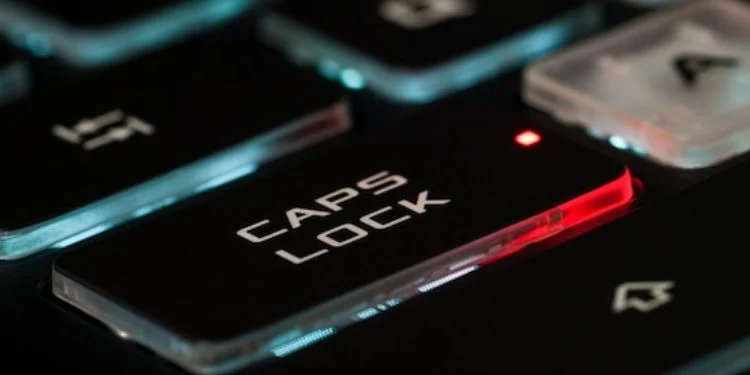In the intricate landscape of technological anomalies, few are as confounding and disconcerting as the blinking Caps Lock light on an HP laptop. This isn’t merely a design oversight or a trivial malfunction; it’s a deliberate diagnostic signal from your device, indicating underlying issues that demand attention. Such signals, while perplexing, are crucial indicators of potential hardware or software discrepancies.
Fortunately, you’ve arrived at a resource designed to demystify this phenomenon. In this comprehensive guide, we will methodically dissect the HP Caps Lock blinking issue, providing both a deep understanding and actionable solutions. As we delve into the heart of HP laptop diagnostics, prepare for a thorough exploration of this common yet often misunderstood challenge.
Blink Codes
Before diving into the solutions, it’s essential to understand what your laptop is trying to tell you. The blinking Caps Lock light isn’t just a random glitch; it’s a Morse code of sorts. HP laptops use blink codes to diagnose hardware failures.
[su_note note_color=”#93e6b7″]Single Blink: CPU error Double Blink: BIOS error Triple Blink: Memory error Continuous Blink: Hardware component failure[/su_note]
By counting the number of blinks, you can pinpoint the root of the problem. Once you’ve identified the issue, you can then proceed with the most appropriate solution.
Hard Reset Your Laptop
A hard reset can solve a multitude of problems. It clears the memory and re-establishes the software connections between the BIOS and the hardware.
Steps to Perform a Hard Reset:
- Turn off the laptop.
- Disconnect all external devices, including USB drives, docking stations, and printers.
- Unplug the AC adapter from the laptop.
- Remove the battery (if it’s removable).
- Press and hold the power button for 15 seconds.
- Reconnect the battery and AC adapter.
- Turn on the laptop.
Check if the Caps Lock blinking issue persists. If it does, move on to the next solution.
Re-seat or Replace the RAM
A common culprit behind the Caps Lock blinking issue is faulty or improperly seated RAM. Re-seating or replacing the RAM can often resolve the problem.
Steps to Re-seat the RAM:
- Turn off the laptop and disconnect all power sources.
- Open the back panel of your laptop. (You might need a screwdriver for this.)
- Locate the RAM sticks. They’re typically long, thin modules.
- Gently release the clips holding the RAM in place.
- Remove the RAM sticks and then carefully re-insert them, ensuring they’re securely seated.
- Close the back panel, reconnect the power, and turn on the laptop.
If the problem persists, consider replacing the RAM with a new module. Ensure it’s compatible with your HP laptop model.
Update or Roll Back the BIOS
The BIOS (Basic Input/Output System) is the software that initializes the hardware during the booting process. An outdated or corrupted BIOS can lead to the Caps Lock blinking issue.
Steps to Update the BIOS:
- Visit the official HP website.
- Navigate to the “Support” section and search for your laptop model.
- Look for the latest BIOS update and download it.
- Follow the on-screen instructions to install the update.
If you’ve recently updated the BIOS and started facing the issue, consider rolling back to the previous version.
Check for Hardware Failures
If none of the above solutions work, there might be a hardware component failure. It could be the motherboard, overheated CPU, or another critical component. In such cases, it’s best to consult with a professional.
Steps to Diagnose Hardware Failures:
- Turn off the laptop.
- Press the power button and immediately start tapping the “F2” key.
- This will launch the HP PC Hardware Diagnostics UEFI menu.
- Choose the “System Tests” option.
- Run the “Quick Test.” If it detects any issues, it will provide solutions or error codes.
If the Quick Test doesn’t find any problems, consider running the “Extensive Test.” It’s longer but more thorough.
FAQs

Can external devices like USB drives or printers cause the Caps Lock blinking issue?
While the primary causes of the Caps Lock blinking issue are often internal, malfunctioning or incompatible external devices can sometimes cause conflicts or power issues. It’s always a good idea to disconnect all external devices to rule out this possibility when troubleshooting.
Is it safe to update the BIOS on my own, or should I consult a professional?
Updating the BIOS is generally safe if you follow the manufacturer’s instructions carefully. However, interruptions (like power outages) during a BIOS update can cause significant issues. If you’re unsure or uncomfortable with the process, consulting a professional is recommended.
How often should I update my BIOS to prevent such issues?
It’s not necessary to update your BIOS frequently. Only consider updating if there’s a specific fix or feature you need, or if you’re troubleshooting an issue like the Caps Lock blinking problem. Always check the release notes of a BIOS update to see what it addresses.
If the Caps Lock blinking issue is due to a hardware failure, is it covered under warranty?
If your HP laptop is still under warranty, hardware failures should typically be covered. However, the coverage might vary based on the type of warranty, the region, and the nature of the damage. It’s best to check with HP’s customer service or refer to your warranty documentation.
Can software or operating system updates cause the Caps Lock blinking issue?
While the Caps Lock blinking is primarily a hardware diagnostic tool, software conflicts or corrupted system updates can sometimes cause system behaviors that trigger the blinking. It’s less common, but always ensure your operating system and drivers are updated and free of conflicts.
Are there any tools or software I can use to diagnose the Caps Lock blinking issue further?
Yes, HP provides the HP PC Hardware Diagnostics UEFI tool, as mentioned in the article. Additionally, third-party diagnostic tools can help identify hardware and software issues, but always ensure they’re from reputable sources to avoid malware or other complications.
Final Words
The HP Caps Lock blinking issue might seem daunting at first, but with a systematic approach, you can identify and resolve the problem. Remember to always handle your laptop with care, especially when opening it up or handling internal components. If you’re ever in doubt, it’s always a good idea to consult with a professional or reach out to HP support. With patience and persistence, you’ll have your HP laptop running smoothly in no time.

